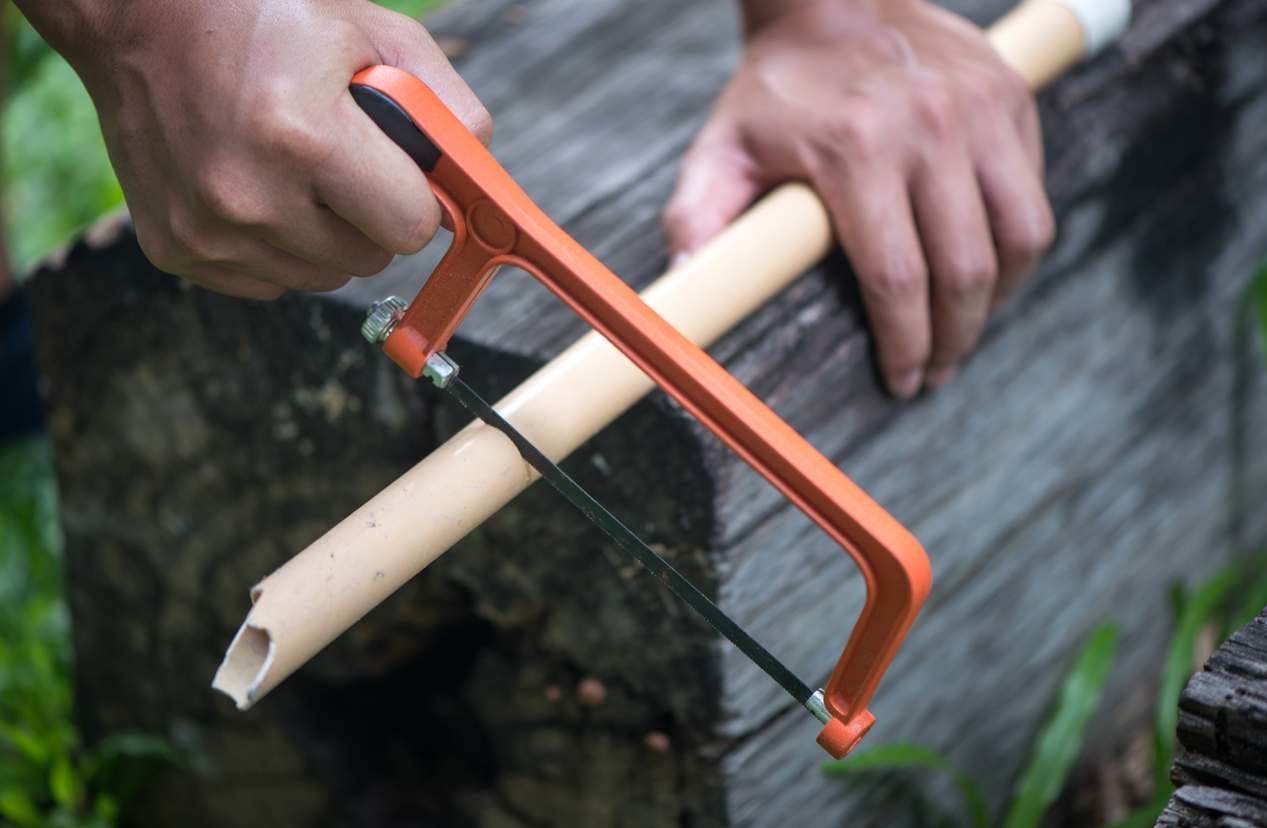Wondering what are PEX plumbing disadvantages? You have probably been overwhelmed by the diversity of products at hardware stores.
When it comes to plumbing systems, PEX is one of the commercially-available alternatives. However, PEX is often related to concerns such as ‘is PEX safe?’ or ‘why is PEX banned in California?’ [1]
In this article we will discover together what is PEX plumbing system and its advantages and disadvantages. Keep on reading to discover when PEX can be used effectively and when it is not a suitable option.
What is PEX?

PEX is a flexible plastic used as an alternative to traditional copper for water supply lines.
PEX is easy to recognize due to the blue and red color of the pipes, which come in rolls due to being flexible. Red PEX pipes carry hot water, blue pipes indicate cold water, and white can be used for both. There are also grey PEX pipes, for mixed use.
PEX is actually called cross-linked polyethylene and comes in sizes from ¼ inch to 4 inches in diameter. There are three types of PEX pipes: PEX-A, PEX-B, and PEX-C. [2]
Each type of PEX is obtained through a different manufacturing method:
- PEX-A is manufactured using the “Engel” method, named after the German inventor Dr. Thomas Engel. The method is also called hot crosslinking because polyethylene molecules are linked during the extrusion process.
- PEX-B is a stiffer product obtained by crosslinking after the extrusion process. The pipe is placed in a hot water bath or steam sauna.
- PEX-C begins with the extrusion process, after which an electron beam changes the molecular structure of the material.
A short history of PEX

The history of PEX begins in 1968, when German scientist Thomas Engel crosslinked polyethylene to obtain a suppler material. His method uses radiation to crosslink common plastic and obtain flexible PEX pipes.
The first use of PEX in the United States dates from the 1980s, when these pipes began to be used for radiant floor heating systems. PEX is still a popular choice for floor heating up to this day.
At the same time, PEX was becoming a first choice for water supply systems in Europe. The early version of PEX used in the United States did not withstand the higher chlorine levels in drinking water. This has caused many of the PEX plumbing systems to deteriorate.
Several improvements have been made, such as adding antioxidants during manufacturing and improving fittings. As a result, PEX is once again a common choice for residential water supply systems.
However, some of the deterioration cases of older PEX plumbing systems has affected this product’s reputation. “Is PEX safe?”, you might ask. Keep on reading to find out when PEX can be used successfully.
Benefits of PEX plumbing

Before finding out what are PEX plumbing disadvantages, you should know this material provides multiple benefits.
Otherwise, it would not have been used on a wide scale and still remain a viable option.
- Very flexible
If you use copper or galvanized steel, you will have to create lots of smaller branch lines for each fixture. Copper and other plastic pipes will require the creation of elbow joints. PEX, on the other hand, can connect to a PEX manifold and go through walls and floors to each fixture.
Using a single length of PEX for each fixture in your home eliminates the risk of leaks at connection sites. It also reduces the drop in pressure due to turbulence that occurs at transitions. As a result, you will enjoy greater water pressure at your fixtures. This solution is only possible due to PEX’s outstanding flexibility.
- Easy to install
Installing PEX does not require soldering, like copper and galvanized steel. No fire torch is needed, thus eliminating fire hazard. You just need proper PEX tool.
- Resistant to freeze-cracking
Unlike copper or steel, PEX expands and can resist to low temperatures. PEX has an expected lifetime of 50 years. This makes it a perfect candidate for replacing metal and thermoplastic pipes.
- No contamination of the water supply
Copper and steel can corrode, potentially causing leaks and contamination of the water supply.
- Silent flow of water
Metal piping is associated with a ‘water hammer’ noise, while PEX allows water to flow silently.
- Adaptability
You can connect PEX to existing metal supply lines if you use the right fittings.
- Lower costs
Alternatives cost around four times more than PEX plumbing systems. The price of copper is affected by various factors related to the health of global economy. In the first quarter of 2021, the price of copper reached their highest level in nearly a decade.
Related: PEX A vs PEX B
PEX Plumbing Disadvantages

If PEX has so many good qualities, then why is PEX banned in California?
PEX is not bad itself; this affordable and excellent material is simply not the best option for certain applications. Here are the main drawbacks of PEX – read and decide whether PEX is right for your project or not:
- Being degraded by sunlight
PEX is not a good option if the pipes will be exposed to sunlight. It takes just a couple of months for PEX pipes exposed to UV radiation to fail. Our recommendation is to avoid PEX for outdoor applications.
- Health concerns
It is possible for PEX to leak BPA and other toxic chemicals, especially for type A and type C PEX. There was even a huge controversy in California in the 2000s regarding health risks associated with PEX.
So, coming back to the question “why is PEX banned in California?”, it is not. Its statewide adoption was delayed for almost a decade due to these concerns. However, consensus was reached and the use of PEX was permitted in the state. New studies also reveal some potential health concerns.
- Vulnerable to insects
It appears that PEX tubing can be perforated by certain plant-eating insects, such as the Western conifer seed bug. Even mice can chew through PEX pipes. The result is leakage and damaged plumbing systems. If you opt for PEX, you need to keep your home pest-free.
- Semi-permeable
The semi-permeability of PEX means that liquid can enter the pipe, causing contamination.
Alternatives to PEX plumbing systems

If you don’t want to use PEX because of PEX plumbing disadvantages, you should know there are several alternatives. Each alternative comes with its pros and cons – there is no perfect material for building plumbing systems:
- PVC
PVC pipes are mostly used for vent systems and drain lines. Polyvinyl chloride pipes are known for their light weight, easiness of use, and simple installation. Their disadvantages include not being able to unjoin them, fragility, and leaking issues.
- Copper pipes
Copper pipes are preferred in many projects for water supply lines. They have been in use for a long time and are trusted and tested by plumbing professionals. They are not suitable for beginners as you need experience to join them together – welding is required. Other drawbacks are the high cost, corrosion issues, and being prone to pinhole leaks.
- ABS pipes
ABS stands for acrylonitrile butadiene styrene and is used due to being non-toxic and abrasion-resistant. These pipes are found in vent systems, drain lines, and electrical cable insulation.
Are ABS pipes suitable for water supply systems? They are not allowed by current building codes due to the risk of deforming at certain temperatures.
PEX vs Copper

When it comes to water supply and home plumbing systems, the battle is usually carried between copper and PEX.
Copper offers one main advantage: it lasts longer than PEX (50 to 70 years).
The main problem with PEX is that very hot household water and high levels of chlorine can damage these otherwise reliable pipes. Copper pipes, on the other hand, can be damaged by acidic water. Even so, copper will outlast PEX for 20 years when used in residential plumbing systems.
PEX, still, is often preferred due to:
- Lower costs
- Being more DIY-friendly
- Being less likely to freeze and break
- Allowing for the creation of a central shut-off
- Requiring fewer connections and less work to install
Related: Copper vs Plastic Pipes
Is PEX right for you?
So, the actual question is not “Is PEX safe?” or “Why is PEX plumbing bad?”
The question is whether PEX is right for you. Now you probably know more PEX plumbing disadvantages.
The truth is that there is no perfect material for water supply or floor heating. Each alternative to PEX comes with its own drawbacks, such as higher installation costs or poorer performance.
The right decision depends on your plumbing needs, plumbing system location, and the types of fixtures you will be using.
Read Also: Why Is PEX Plumbing Bad

Michael Davis is a heating & plumbing expert who currently works as independent contractor in SC. He also writes for Plumbertip.
For almost 10 years he worked on various plumbing tasks across South Carolina.



